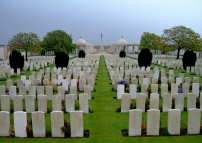| First Name: | Alfred Edward | Last Name: | PEAK | |
|---|---|---|---|---|
| Date of Death: | 25/09/1915 | Lived/Born In: | Nunhead | |
| Rank: | Private | Unit: | London7 | |
| Memorial Site: | Loos Memorial, France | |||
Current Information:Enlisted-Sun Street, Finsbury The Battle of Loos This battle, fought by the British Army from 25th September, 1915 through to 13th October, was conducted along a six-and-a-half-mile front running north from the mining village of Loos on the outskirts of Lens in Northern France. It was the largest offensive carried out by the British so far in the war. The opening day involved an attack by six divisions, with others entering the fray as it progressed and it was part of a much wider offensive with the French launching their own attacks in Champagne and at Vimy. It was the first time that the British used gas during the war, despite their condemnation of the Germans for doing the same in April 1915. There were some encouraging results on the first day but no major breakthrough was achieved and in the successive days the offensive became mired in trench warfare. By mid-October the battle had petered out with the British having suffered over 60,000 casualties during its course On 25th September, 1915, 47th (2nd London) Division attacked on the right of the British line with French troops holding a passive front in front of Lens on their right. They held a 2500 yard front and had as their objectives the great dumps of Fosse 11 and Fosse 12, the Double Crassier and the Loos Crassier. The waste from these pits had been shot into the valley rather than built up into a pyramid, forming two high embankments. Double Crassier was two 1200 yard long embankments about 100 feet high. The Loos Crassier was one 800 yard embankment, 150 feet high. At the north end of the Loos Crassier were the two lattice girder wheel houses. ‘Loos Pylon’ and ‘Tower Bridge’. The gas travelled well in this sector and there was also lots of smoke which concealed the advance. On the right 140 Brigade was charged with taking the German support trench running from the Double Crassier to the Béthune road and attacked at 6.30am with 7th London and 6th London in successive lines, 50 paces apart. 8th London (Post Office Rifles) followed in close support and had the task of supporting the pivot of the attack, the Double Crassier. Within minutes the leading troops were in the German trenches, where the defenders, mostly emerging from dug-outs, were either killed, captured or fled. Two machine guns offered the only effective opposition and were soon captured but there was some enfilade fire to contend with from Cité St. Pierre, a mining community, part of the suburbs of Lens. By 7.30am both 7th London and 6th London had reached their final objective and were consolidating. A desperate German bombing attack on the right flank of 7th London was repulsed, but not without cost. |
||||
| « Back to Search Results | ||||
| If you think any of the information shown here is incorrect, Click Here to submit your amends and comments | ||||




